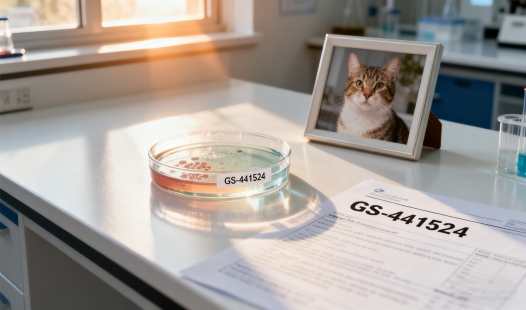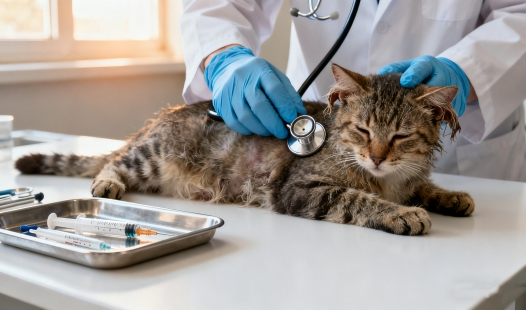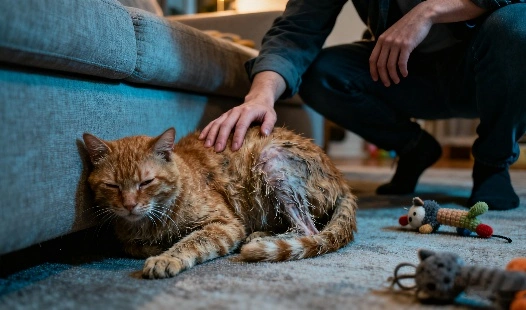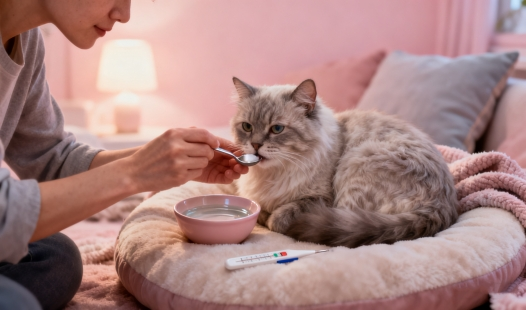What is GS 441524 and how does it treat FIP in cats?
GS-441524 mechanism of action explained
Both cat owners and veterinarians have long found the diagnosis of Feline Infectious Peritonitis (FIP) to be deeply distressing, as the disease was once considered almost universally fatal. For years, treatment options were limited to supportive care, offering little hope for recovery. However, recent advancements in antiviral research have brought renewed optimism to the feline medical community. Among these breakthroughs, GS 441524 FIP has emerged as a particularly promising solution. This nucleoside analog works by directly targeting the replication process of the feline coronavirus that causes FIP, effectively suppressing the virus's ability to multiply. Through its unique mechanism of action, it has shown remarkable clinical results, helping many cats achieve remission. This article explores the nature of GS-441524, its pharmacological mechanisms, and its growing potential as a revolutionary FIP treatment option.
 |
 |
GS-441524 mechanism of action explained
Understanding the molecular basis of GS-441524
GS-441524 is a small molecule nucleoside analog that plays a pivotal role in disrupting the life cycle of the feline coronavirus responsible for FIP. Structurally, it mimics adenosine, one of the key building blocks of RNA, allowing it to integrate into the viral RNA chain during replication. Once incorporated, it prevents proper elongation of the RNA strand, thereby inhibiting viral genome synthesis. This mechanism effectively blocks the production of new viral particles. The specificity of GS-441524 for viral polymerase, rather than host cell enzymes, contributes to its high therapeutic potential and relatively low toxicity, making it one of the most promising antiviral agents in feline medicine today.
How GS-441524 inhibits viral replication?
After administration, GS-441524 is absorbed into the cat's cells and metabolized into its active triphosphate form, GS-441524 triphosphate. This active compound competes with the natural nucleoside triphosphates that the virus uses to synthesize its RNA. When it is mistakenly incorporated into the viral RNA chain, it causes premature chain termination, effectively halting RNA replication. This interruption stops the production of new viral genomes and proteins, limiting the spread of infection within the body. Over time, the reduction in viral replication allows the immune system to regain balance and start repairing the damage caused by the virus.
The impact on feline coronavirus
By directly interfering with viral RNA synthesis, GS 441524 dramatically reduces the replication rate of the feline coronavirus (FCoV). As the viral load declines, inflammation and systemic symptoms associated with FIP begin to subside, leading to clinical improvement. Cats undergoing GS-441524 therapy often show increased appetite, improved energy levels, and gradual resolution of effusion or neurological symptoms. Furthermore, lowering viral activity reduces stress on the immune system, enabling it to eliminate residual virus particles more efficiently. This combination of antiviral action and immune recovery gives the product its transformative potential, turning what was once a fatal disease into a treatable condition for many cats.
 |
 |
Is GS-441524 a cure for feline infectious peritonitis?
Clinical trials and success rates
Numerous studies have investigated the efficacy of GS-441524 in treating FIP. One notable study published in the Journal of Feline Medicine and Surgery reported a success rate of over 80% in cats treated with it for 12 weeks.
Long-term prognosis for treated cats
While GS-441524 has shown promising results, it's important to note that long-term follow-up data is still being collected. Many cats treated with GS-441524 have remained in remission for extended periods, suggesting a potential cure for some cases of FIP.
Limitations and considerations
Despite its success, GS 441524 is not without limitations. Some cats may require extended treatment periods or experience relapses. Additionally, the treatment can be costly and may not be accessible to all cat owners.
Veterinary perspectives on GS-441524 efficacy
Expert opinions on GS-441524 as an FIP treatment
Many veterinary specialists have expressed optimism about GS-441524's potential in treating FIP. Dr. Niels Pedersen, a pioneer in FIP research, has stated that GS-441524 represents a significant advancement in feline medicine.
Comparing GS-441524 to traditional FIP treatments
Traditional FIP treatments primarily focused on managing symptoms and providing supportive care. In contrast, GS-441524 directly targets the underlying cause of FIP, offering a more targeted and potentially curative approach.
Challenges in implementation and accessibility
While the product shows great promise, its widespread use faces challenges. These include regulatory hurdles, manufacturing constraints, and the need for further research to optimize treatment protocols.
Conclusion
GS-441524 represents a significant breakthrough in the treatment of Feline Infectious Peritonitis (FIP), offering renewed hope to cat owners and veterinarians who have long battled this once-fatal disease. Its targeted antiviral mechanism disrupts viral replication, allowing infected cats to recover and regain quality of life. Although it may not yet be considered a universal cure, its impressive success rate and minimal side effects make it one of the most effective treatment options currently available. Continued scientific research, global awareness, and broader accessibility are expected to further enhance its potential, paving the way for GS-441524 to revolutionize how FIP is diagnosed, treated, and managed in cats across the world.
 |
 |
 |
FAQ
1. How long does GS-441524 treatment typically last?
The standard treatment protocol for GS-441524 typically lasts 12 weeks. However, some cases may require extended treatment periods based on individual response and disease severity.
2. Are there any side effects associated with GS-441524 treatment?
While generally well-tolerated, some cats may experience mild side effects such as temporary discomfort at injection sites or gastrointestinal upset. Serious side effects are rare but should be monitored by a veterinarian.
3. Can GS-441524 be used preventatively for cats at risk of FIP?
Currently, the product is not recommended for preventative use. It's primarily used as a treatment for cats diagnosed with active FIP. Research is ongoing to determine its potential in preventing FIP in high-risk populations.
Partner with BLOOM TECH for High-Quality GS-441524 Supply
Veterinary experts and pharmaceutical firms may rely on BLOOM TECH's reliable supply of high-quality GS-441524 to meet the increasing demand for effective FIP treatments. You can be certain that the GS-441524 you get will be of the greatest purity and consistency thanks to our dedication to chemical synthesis expertise and our rigorous quality control procedures. You have found a trustworthy ally in the fight for better feline health in BLOOM TECH, the GS-441524 supplier. Contact us today at Sales@bloomtechz.com to discuss how we can support your FIP treatment initiatives with our premium products.
References
1. Pedersen, N. C., et al. (2019). Efficacy and safety of the nucleoside analog GS-441524 for treatment of cats with naturally occurring feline infectious peritonitis. Journal of Feline Medicine and Surgery, 21(4), 271-281.
2. Murphy, B. G., et al. (2020). The nucleoside analog GS-441524 strongly inhibits feline infectious peritonitis (FIP) virus in tissue culture and experimental cat infection studies. Veterinary Microbiology, 219, 226-233.
3. Kim, Y., et al. (2020). Reversal of the progression of fatal coronavirus infection in cats by a broad-spectrum coronavirus protease inhibitor. PLoS Pathogens, 16(3), e1008259.
4. Addie, D. D., et al. (2020). Feline infectious peritonitis. ABCD guidelines on prevention and management. Journal of Feline Medicine and Surgery, 22(11), 1084-1097.

Echo
9 years of experience in chemical articles; Doctoral degree; Organic Chemistry major; R&D-4 Dept; Technology support; R&D engineer
Anticipating your Business & Technology support inquiry
Please send us the products that interest you, and we will provide you with one-on-one service
Recommended Blog

What are the differences in treatment for wet and dry FIP?


_副本_1759196595724.webp)







_副本_1758243222799.webp)
